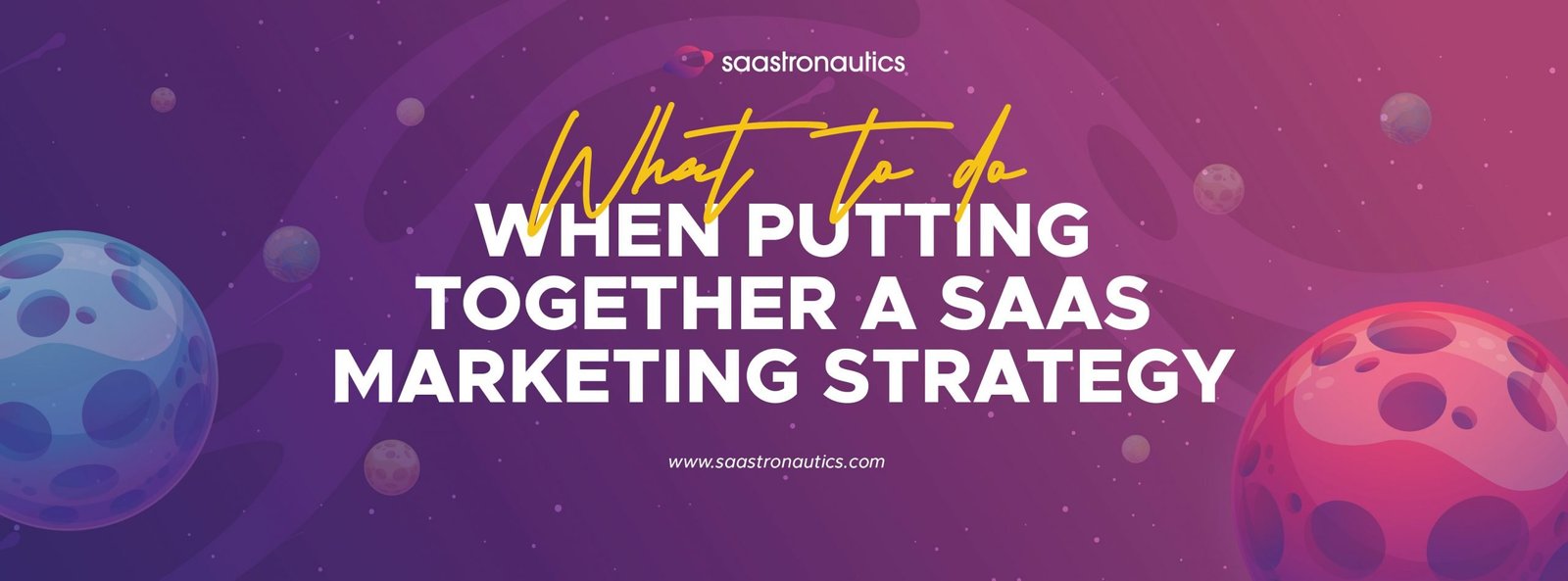Effective SaaS Marketing Strategies
The SaaS (software as a service) market is changing all the time and booming now more than ever. It wasn’t too long ago that the greatest marketing strategy available was door to door sales. Now, competition is global and takes place on “the cloud”. SaaS marketing has taken the global business world by storm within the last two decades, and now, most high-level businesses use some form of SaaS.
There are lots of different pieces to the puzzle of having a successful marketing strategy for your SaaS company. However, before you get started there are several things you will want to take him to account. We have compiled a list of some of the most important SaaS marketing tips we use ourselves.
Things You Need to Know!
Revenue & Statistics
In a report by Synergy Research Group, the Enterprise SaaS industry generated over $23bn in revenue in Q1 2019. While it was projected to hit $100bn, the SaaS industry came short, pulling in just over $98bn. The industry is expected to see exponential growth in the next two years, as more and more businesses identify the need for SaaS.
The major SaaS players listed in the chart above have produced the most enviable results of 2019. Looking at the strategies used by companies such as Microsoft, SAP, and Adobe will provide invaluable insights as you begin to create your own marketing strategies to grow your own SaaS company.
According to an article by Virayo, there are over 11,000 SaaS companies in the world. With this industry growing by leaps and bounds, there is flaming hot competition between the existing companies and emerging ones.
Marketing Your Product – Build on what your company can and cannot handle
One major thing you need to consider when creating your marketing strategy is the size of the company you are wanting to service, or more importantly, the size of the company you can effectively add value to.
A smaller company will have different focuses, goals, and budget sizes than that of a larger company. If your SaaS company does not have the capacity to effectively service an enterprise, don’t solicit your services to them as though your SaaS can handle the needs of a company with thousands of employees and billions of dollars in revenue. Of course, this does not mean you can never target the big boys. It’s just important to not bite off more than you can chew.
Larger SaaS companies who have established clientele and support services are able to use the sign-up marketing model because of the fact they already have their names established. For example, if Microsoft ran an advertisement for a discounted service for new users they could effectively use a sign up model. On the other hand, a newer SaaS company that is trying to build a base of clientele should be more focused on building stronger relationships with customers. This will likely involve social media marketing and phone calls to small businesses to assess if your service can benefit them as well as what types of SaaS services are currently being used. When selling your product, don’t be shy to get down on the ground and get your hands dirty.
Why makes your SaaS unique? This is the ace up your sleeve! Your strategy when creating your marketing strategy should be focused on who you are marketing to. For example, if your ads are marketed towards mom and pop kind of places that still need your software, then you want to drive home why your personal touch and customer service is the best. Your goal is to create a strategy that can cater to the specific needs of their growing business because these are the companies that will have a lower churn rate if a good relationship is established.
The Marketing Funnel
Think about the various social media platforms that you visit on a daily basis. Most people have some (if not all) of the following platforms in the palm of their hand: Facebook, Instagram, Snapchat, Twitter, Pinterest…just to name a few. These various platforms serve as a worldwide marketplace for your new up-and-coming SaaS company. You want to use not just one, but various marketing strategies that are the most effective on each individual social media platform. This will enable you to effectively promote your company to the most suitable users in the shortest amount of time possible.
Take a look at the Marketing Funnel infographic above. First off, we see awareness and the need to create an audience. Creating a large audience is most efficiently achieved through social media. Consideration is the second stage of this funnel. Here, maybe the customer has clicked a link. However, they are still only considering your services. It is crucial to build a relationship with them at this point. From this point you have conversion (SELL your product), Loyalty, and Advocacy.
When first establishing effective Social Media Marketing, consider the demographic of people you are trying to reach. For example, according to Pew Research, Facebook is the most popular among all demographics and is the most often used. However, Twitter or Discord would have much more inroads to niche markets in finance, technology and more, while Reddit would provide communication to some of the internet’s brightest nerds. Social media campaigns can be a fun and effective way to promote your business. Remember to do A/B testing on whatever platform you use, as different types of posts will have different rates of success.
Promises, Promises
Knowing what promises you can and cannot make is going to be vital in creating your marketing plan. Not only that, you want to make sure to maintain a strong professional relationship with your customer that is based on respect and clear expectations of the product and service to be received. No customer likes to feel lied to or deceived. Even if you manage to deceive one customer, they can always take it upon themselves to share their bad experience on as many social media platforms as possible.
Contracts with customers are professional promises that secure business with one another. Think about your own staff, the capabilities of your software, technicians available either in person or via telephone, etc. It may be really tempting to be a “yes man” when you are trying to seal the deal and make that sale, but your relationship with a customer that feels deceived will always be a short lived one. Furthermore, happy customers who have had all promises kept and great customer service are likely to tell others about your company and how great it is. A great customer review can be worth more than the most far-reaching campaigns!
Great customer care should always be part of your promise to your potential clients. Being real with customers when something goes wrong is vitally important, but even more so is your apology if you fail to fulfill a promise. There is nothing more frustrating than having to call a number to get transferred around what seems like a thousand different times just to get someone to do what should have been done in the first place. In your sales pitch and promises, be clear with your customer as to how complaints will be handled and that redirecting them over and over will not occur.
Establishing a Price Point & Contract
According to 99Firms.com, in the year 2020, up to 85% of small businesses will invest SaaS. If looking at statistics in the United States, though small business creation rates are declining, that does not mean it is non-existent. New businesses are being created all the time which means there is room for growth with your own company. But with a small business your price point can sometimes make or break a deal.
Read more :
SaaS Marketing Strategy
B2B Online Marketing Strategy
When creating a contract with your customer you should consider the following: your service contract, what the terms of service are, and the purchase order agreement. Your service contract should entail specifically the different services your SaaS will provide.
Your terms of service will include what the software will do specifically as well as any level of customer service that would be needed. For example, if the company needed one of your technicians to come and do a training workshop, this should be listed in your terms of service. Or, if the small business is having technical issues that required you to hire a licensed technician to go out and fix any issues, this also should be listed in terms of service as to how many times this can occur or if at all. This portion of the contract should include any warranties, terms of payment or disclaimers.
Purchase order agreements are vital to the contract and your price point. According to SaaS Capital, determining what your company is worth requires a public market evaluation that is current as well as the current revenue and growth rate of comparable companies. From this point you need to assess the cost of employees, a price point for your product, as well as all other financial factors. Something else to consider in your contract is the churn rate (or turn-over rate). Longer contracts statistically produce significantly lower churn rates than that of shorter ones. 99Firms.com reports that companies with a one year contract or less have a 16.7% churn rate. Whereas SaaS companies that have a 2 year length contact or longer experience a churn rate of 8.5%.
Expect to be haggled with! Who doesn’t want a good deal on whatever they buy? Knowing this already, set your price point higher than where it needs to be in order to achieve your needed revenue. Allow the customer to feel empowered by feeling like you both are working together on a price point that both of you can agree upon.
Marketing Budget
Establishing your marketing budget will be the most important thing you do, next to the actual marketing. Assessing how much your marketing will cost and getting the most bang for your buck will be crucial to the take-off of your SaaS marketing strategy. According to BIGDROPinc.com, newer SaaS companies invest as much as 40% of their growth into marketing. More so, SaaS marketing is going to cost more because internet advertising, simply put, it expensive. This is where those social media platform statistics become the most important to you. For example, according to Pew Research, 7 in 10 adults in the US use Facebook, and 74% of users check Facebook more than once a day. An advertisement on this platform may cost more than you would like to spend, but it could reach more people.
Overall
A whole lot of information was just given to you to consider how to best create a profitable marketing strategy for your SaaS company. Most importantly, do your research and know what the market looks like, in order to evaluate other successful companies and how they got to where they are.
Establish your budget for marketing and then evaluate where and how you want to market. Know how marketing works and adopt the framework of the Marketing Funnel. Know your product, your demographic, and what type of companies would best be served with your SaaS. Lastly, know your price points and how much money you have to work with as well as how much revenue you want to make by the end of the year. For anything else – there’s Saastronautics. Get in touch with our team today to learn how we can help you get your SaaS product to the most users in the shortest possible amount of time. SaaS Marketing Strategy








